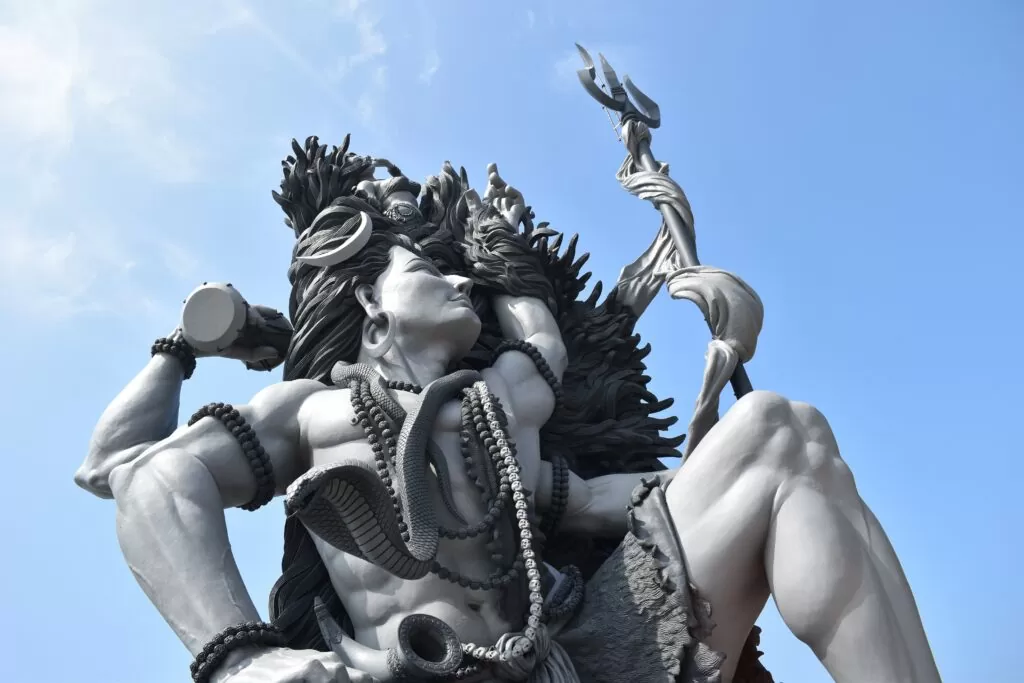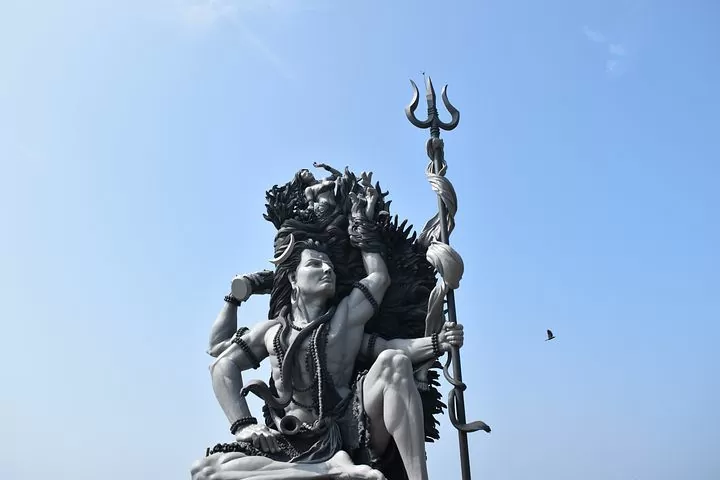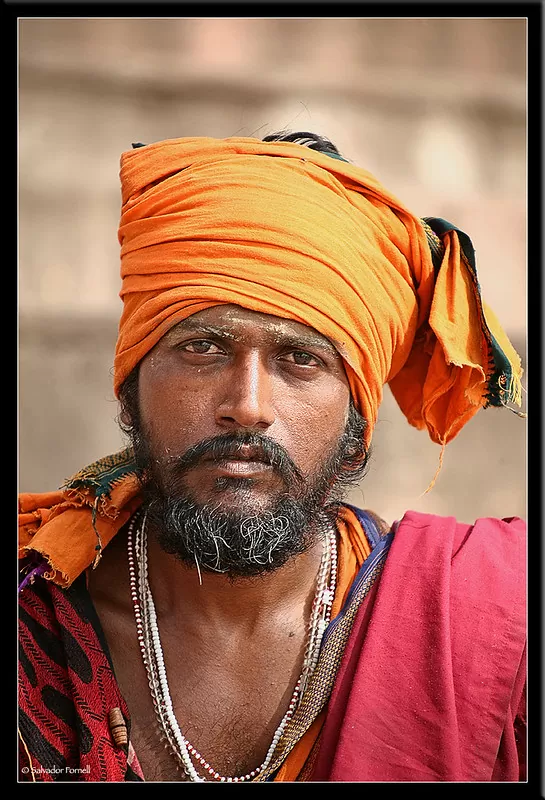Turquoise waters, golden shore, rocky beach and a magnificent statue of Lord Mahadeva in Gangadhareshwara figure. This is enough to send chills in the heart of every travel lover and a true Mahadeva devotee. Wondering which place we are talking about? Well, the answer is Aazhimala Shiva Temple of Kerala.
The Aazhimala Shiva temple of Kovalam (Thiruvanathapuram), Kerala is surrounded by an aura of peace and serenity. The tall concrete structure of Mahadeva stands above the sparkling waters of the Arabian Sea. Lord Shiva Temple in Thiruvanathapuram depicts an enormous structure of Mahadeva in Gangadhareshwara figure, with his hair blowing in the air and carrying Devi Ganga on his head.
We have seen this statue many times at TikTok and Instagram Reels, but have you ever thought of knowing more about this temple. So, now we will be going to know many amazing facts about this temple and will know who is the architect of the Aazhimala Siva temple.
The word “Aazhi” means “sea” and “Mala” means “Hill”. Thus, the name – Aazhimala perfectly suits the temple as it is located on the shore of the Arabian sea surrounded by beautiful rocks.
Aazhimala Shiva temple –A serene blend of sanctity and mother nature
Aazhimala Siva Temple is one of the famous Lord Shiva temples in India. This is the center of the holy place where you can get the blessings of Mahadev. You can visit this temple located near Vizhinjam in Thiruvananthapuram, Kerala.
The statue is inspired by the well-known mythological tale of Lord Shiva locking mighty Ganga in his hair strands at the request of Bhagiratha. This story unfolds great lessons for the present and future generations. As only a strong and stable mind (such as of Lord Shiva) can control the temptations of the materialistic world (Ganga’s force).

Aazhimala Temple Timings
- Weather: 28°C
- Timings: 5 A.M. – 9 A.M.
- Entry Fee: No Entry Fee
Gangadhareshwara Statue
The Aazhimala Lord Shiva Temple of Thiruvanathapuram is admired by thousands of devotees for the mesmerizing sculpture of Lord Shiva, which was built by a 29-year-old artist, P.S Devadathan, from concrete due to topographical reasons.
P.S Devadathan, the sculptor of the Gangadhareshwara statue, graduated in sculpture from Fine Arts College in Thiruvanathapuram. He was pursuing post-graduation when he finished making the Lord Shiva statue in the Aazhimala temple.
The alluring sculpture of Lord Shiva stands on a rock situated at an altitude of 20 ft. from the sea. According to Devadathan, the statue is built at a higher altitude to resist the sea wind and salty air. It took almost six years for Devadathan to complete the Gangadhareshwara statue. The sculpting journey started in the year 2014. The concept of the Gangadhareshwar idol was suggested by the chief priest – Jyotish Potti.
The Aazhimala Lord Shiva Temple has a uniquely exquisite statue with a chamber of 3,500 sq. ft., having more sculptures that show the history of the Aazhimala Shiva temple. Twenty-seven steps lead to this cave-like chamber which has a Dhyana Mandapa inside it. The walls of the chamber depict the history of the temple.
The astonishing masculine figure of Lord Shiva can be seen gazing at the sky. The statue depicts a chaturbhuj avatar holding sacred Trishul in the left hand a damru in the right one. Another left hand can be seen releasing Devi Ganga from the hair strands while the right one is resting on the thighs. The Crescent moon placed at the crown of the statue signifies Chandrashekhara’s incarnation of Mahadeva. The idol is shown wearing tiger skin, rudraksha beads, and a serpent over his neck. The third eye carved in the middle of the forehead is symbolic that Lord Shiva is a “Trikaldarshi” i.e. viewer all three periods, be it past, present, or future.
History of Aazhimala Temple
The history of the Aazhimala Temple dates back to the era of Mahabharata. It is believed that Aazhimala was one of the hideouts of Pandavas during their exile. According to folklore, when Panchali was thirsty, Bheema created a freshwater stream by making a hole in a rock with his knees to quench her thirst. This freshwater stream can still be seen flowing from one of the caves.
The temple is said to be made during 16th Century.
The original name of the temple was Aazimala Pulinkudi Sree Mahadeva Temple. Years ago, it was called ‘Pullikudi’ due to the presence of cheetahs in that region. Gradually, the name changed to ‘Pullingudi’.
The main festival of Aazhimala Temple – Naranga Vilakku
Naranga Vilakku is the main festival of Aazhimala Temple. This festival is usually celebrated in January – February. Hundreds of lighted lamps on the seashore in the evening are a pure delight to the eyes.
Aazhimala Shiva Temple pooja timings:
The priests of Aazhimala Temple conduct several poojas on daily basis. These include Vivedam Abhishekams and Archanas, which usually cost between Rs. 5 – Rs. 150.
The four main poojas conducted at Aazhimala Shiva Temple are:
- Pradosham Pooja
- Udayaastamaya Pooja
- Uma Maheshwari Pooja
- Divasa Pooja
PRADOSHAM POOJA:
Pradosham pooja is conducted to get rid of one’s sins. It is half an hour-long pooja conducted twice a month – the 13th day after New Moon and after Full Moon. According to residents, Pradosham pooja is highly effective at Aazhimala Temple as Lord Shiva’s sacred calf and vahana – Nandi, was sent on earth to this temple for the sin nullification process.
COST: Rs. 3001
UDAYASTHAMAYA POOJA:
“Udaya” literally means “rise” or “rising” and “asthama” means “setting”. Together the word “udayasthama” means the period between sunrise to sunset. Pooja conducted during this period is called Udayasthama Pooja.
The pooja can be further divided into Usha pooja, Ucha Pooja, and Athaza pooja.
COST: Rs 5001
UMA MAHESHWARI POOJA:
Uma Mahershwari pooja is essentially conducted for the long and happy life of married couples. Lord Shiva and Shakti (Goddess Parvati) are together considered as “Ardhanareshwara”. Worshipping Lord Shiva and Mata Parvati removes any hurdles in the way of the marital life of couples. It is advised that pooja should be conducted once a year for a peaceful married Pooja.
COST: Rs 1501
DIVASA POOJA:
Divasa pooja is conducted for cleansing the body and purifying the souls of Mahadeva devotees. This pooja is conducted throughout the day with or without Muzhukappu.
COST (with Muzhukappu): Rs 2001
COST (without Muzhukappu): Rs 1501
Other poojas conducted at the temple are:
- Shanghabhishekam
- Vahana pooja
- Chooroonu
- Vidhyarambham
- Thali pooja
- Thulabharam
- Payasam vaikittu
- Rudrabhishekam
- Paal payasam
- Thikala homam
- Mrithyunjaya homam
- Naagaroottu
- Maha sudarshana homam
- Mandala Chirappu Pooja
How to reach Aazhimala Shiva temple:
TThe Aazhimala Shiva temple is located in between Trivandrum and Kovalam. Trivandrum Central Railway Station is almost 20 km away from the Aazhimala Shiva temple and is the closest railway station from the temple. Once you reach the railway station, you can easily find a cab or auto outside the station, which will take you directly to the Aazhimala Shiva temple.
Another cheapest yet fastest way to reach Aazhimala Shiva temple is to take a bus that starts at East Fort Bus Stand. The bus will take you to Aazhimala Bus Stop, which is at a distance of approximately 100 meters away from the Aazhimala Shiva temple.
Best time to visit Aazhimala Shiva temple:
The Aazhimala Lord Shiva temple is considered to be the most preferred tourist destination of the state, Thiruvananthapuram, because of its vibrant culture, gorgeous beach, and boundless religious significance, which makes it a vivacious destination for tourism.
Even though the Aazhimala Lord Shiva temple is enjoyable throughout the day, the best time to visit and explore the location is during sunrise and sunset. The elegant golden shore and sparkling turquoise waters offer the best view during sunrise and sunset.
During sunset, the Aazhimala Lord Shiva temple offers an angelic, spiritual vibe that will make you ponder that you have slipped into paradise. The horizon changes from minute to minute. From bright red to fiery orange, the sky is painted in delightful colors all around.
The sky is filled with a variety of colors, and the sea below shows a lovely reflection of the enthralling sky, which offers a beautiful sight for the tourists of the Aazhimala Shiva temple.
The Aazhimala beach appears to be live and alluring and is considered to be one of the best beaches of Southern India. Therefore, it is advised to spare some time after the Pooja to enjoy the mesmerizing beauty of the beach, preferably during the sunrise and sunset.


Dress Code for Aazhimala Temple:
| For Men: Shirt and trousers, Dhoti or Pyjamas with an upper cloth. |
| For Women: Saree or a half-saree with a blouse, Chudidar, Pyjamas with kurtas. |
| Note: Shorts, miniskirts, sleeveless tops, low-waisted jeans, and short length T-Shits are not allowed. |
Do’s and Don’ts at Aazhimala Temple:
| Do’s | Don’ts |
| Wearing clean clothes Respecting ancient customs | Smoking Drinking Chewing betel leaves Tobacco and gutka Spitting inside the temple premises Avoiding touching plant |
Amazing facts about Aazhimala shiva temple
- A priest Jyothish Potti who initiated 58 feet tall Gangadhareshwara sculpture in the temple.
- The wish of Sree Narayana Guru to construct a big Mahadev temple is fulfilled by the locals.
- A 29-year-old artist P. S. Devadathan created this sculpture.
- As the name Gangadhareswara depicts the natural beauty of Lord Shiva’s hair flowing in the wind and mother Ganga is entering earth through his head.
- Shri P S Devadathan created this huge concrete statue over six long years on a rock at an altitude of 20 ft from the sea.
- He spent almost eight months studying the topography and climate of the area before the pre-production of the sculpture.
- This structure sculptured such that lord Shiva gazing gracefully at the sky as if invoking bliss in times of trouble.
On a final note, visiting the Aazhimala temple is certainly a dream come true for any Mahadeva devotee and truly defines Kerala as heaven on earth. The massive idol with Lord Shiva’s hair flowing in the wind and clenching Ganga leaves a long-lasting impact on the minds of the visitors. The temple gives a glimpse of India’s glorious culture and surreal blend of divinity and natural beauty.
you can read more about this from here
If you loved the answer. Please write “Har har mahadev” in comment box. You can read more blog related to mahadev from here
About the author:
Simran Mishra, born and brought up in Bhopal and is a postgraduate in finance. She’s passionate about writing, painting, and reading.




Thanks for your blog, nice to read. Do not stop.
Thanks Mark for support, This means alot to us.